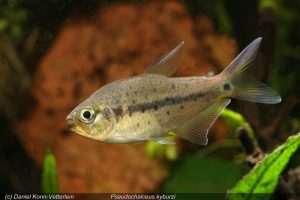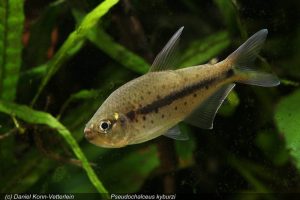taken from report 3-2020
The species was named after the Swiss ornamental fish exporter William A. KYBURZ, who was active in Columbia back then. Amongst others, he introduced Nematobrycon palmeri EIGENMANN, 1911 in the aquarium hobby. The tetra is said to be found west of the Andes, to the west of the town of Buenaventura in the Columbian Cauca valley, which might even suffice as an explanation why this attractive tetra isn’t found in the aquarium trade more frequently. All four species of the genus are practically unknown in the aquarium hobby, which is quite unfortunate.
 The only comprehensive report about successful attempts at breeding this tetra was written by BORNSTEIN (2015). The fish are quite easy to sex: The males are more intensely colored, with a brownish back and reddish fins. They are territorial, and defend their small habitat quite aggressively, even against much larger company fish. In its territory, the male tetra digs several small pits in the gravel, which are later on used for spawning. The females have a blueishgray color above their lateral line, their fins are transparent. During courtship, the female selects one of the pits the male has dug beforehand, and uses it to lay its eggs. The eggs aren’t just laid loosely but attach to the gravel with a fine sticky filament. BORNSTEIN provided his tetras with a varied diet, for example with Spirulina flakes, Artemia and Mysis, all of which was accepted willingly. The presumed trigger for the accidental breeding described by BORNSTEIN was a two-month long phase during which no water was changed at all and during which the breeding tank wasn’t really in the author’s focus. The eggs and the larvae are cared for by the male, until the larvae swim freely and scatter in all of the tank. According to BORNSTEIN, the species is quite productive since it is a permanent spawner. He observed one male to court several females at the same time, and to care for various spawning pits at once in the following.
The only comprehensive report about successful attempts at breeding this tetra was written by BORNSTEIN (2015). The fish are quite easy to sex: The males are more intensely colored, with a brownish back and reddish fins. They are territorial, and defend their small habitat quite aggressively, even against much larger company fish. In its territory, the male tetra digs several small pits in the gravel, which are later on used for spawning. The females have a blueishgray color above their lateral line, their fins are transparent. During courtship, the female selects one of the pits the male has dug beforehand, and uses it to lay its eggs. The eggs aren’t just laid loosely but attach to the gravel with a fine sticky filament. BORNSTEIN provided his tetras with a varied diet, for example with Spirulina flakes, Artemia and Mysis, all of which was accepted willingly. The presumed trigger for the accidental breeding described by BORNSTEIN was a two-month long phase during which no water was changed at all and during which the breeding tank wasn’t really in the author’s focus. The eggs and the larvae are cared for by the male, until the larvae swim freely and scatter in all of the tank. According to BORNSTEIN, the species is quite productive since it is a permanent spawner. He observed one male to court several females at the same time, and to care for various spawning pits at once in the following.
 I have been able to watch a group of subadult Pseudochalceus kyburzi for around a week in the tank of a friend, and I can say these tetras are really interesting. Their habit differs a lot from the tetras we generally see in our aquaria, and their rather robust behaviour is great to observe. Literature is not clear about the maximum length of the species. Most authors list them with a total length of not more than 8 cm, but apparently the species can get bigger. Males grow larger than females and can reach 15 cm, proved by an old individual at Hobbyzoo Neudorf, which was returned by a customer.
I have been able to watch a group of subadult Pseudochalceus kyburzi for around a week in the tank of a friend, and I can say these tetras are really interesting. Their habit differs a lot from the tetras we generally see in our aquaria, and their rather robust behaviour is great to observe. Literature is not clear about the maximum length of the species. Most authors list them with a total length of not more than 8 cm, but apparently the species can get bigger. Males grow larger than females and can reach 15 cm, proved by an old individual at Hobbyzoo Neudorf, which was returned by a customer.
Text and pictures: Daniel KONN-VETTERLEIN